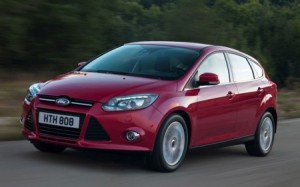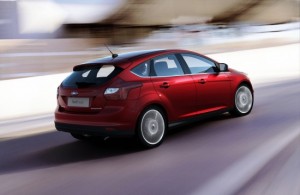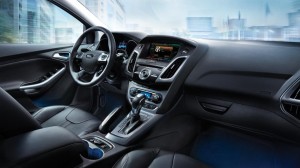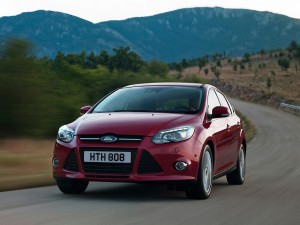The 2012 Focus Signals Ford’s Emphasis on Small Car Refinement and a Little Roughness
For the first time in years Ford has a truly winning small car in its lineup. The 2012 Ford Focus is a refreshingly refined small car available in sedan or hatchback body styles. That refinement becomes obvious upon sinking into the driver’s seat, taking in the interior and driving away. In our case, so did a little roughness.
The new Focus joins the ultra-competitive B segment where, along with Chevy’s Cruze, it constitutes a double-barreled American shot across the bows of the foreign makers who’ve dominated the space for three decades. Against the likes of Honda’s revised Civic, Mazda’s enthusiast-minded 3, Volkswagen’s spacious Jetta and Hyundai’s value-priced Elantra, the Focus compares favorably.
On the market since spring 2011, Focus sales have surged, hampered more by supplier problems than the competition. While the global economic downturn and energy costs have certainly tilted American buyers toward the B segment, the Focus’ success rests on recalibrated American thinking about what an “economy car” can be. Where such cars were previously “efficient” the new Focus is also sophisticated, even “premium”.
That perception begins with an exterior design that doesn’t shout econobox. In fact it’s not a box at all. Multiple belt lines create a Z-shaped pattern, combining with flared wheel arches to lend the Focus some muscularity and visual interest in profile. The roofline and greenhouse are sufficiently high to give the short-decked sedan variant visual balance and good sightlines. The hatchback – the better looking of the body styles for my money – enjoys the benefit of an extended roofline that is almost fastback-ish. An aggressive face with a small grille above a large trapezoidal intake flanked by headlamps give the Focus a furrowed brow look.
The concentrated exterior face compliments an equally serious interior. In the SEL trim Focus I drove, the cockpit is anchored by the MyFord Touch touchscreen which sits atop the center console over the controller for the optional Sony HD radio and HVAC controls. The touchscreen and its iconography give the Focus dash a look found not very long ago only in premium luxury sedans. White and blue hued driver’s binnacle instruments separated by another digital display complete the contemporary information-rich look.
However as good as it may look, MyFord Touch needs a touch more development. The touchscreen interface is slow to react and its symbology is small. The result is too much driver attention on the screen and too little on the road, an accident-inducing combo.
Cloth driver and passenger chairs prove firm but comfortable after more than the usual fiddling with rake and height settings. Rear seat comfort is merely good with legroom made acceptable more by scalloped front seatbacks than actual space. The Focus hatchback’s 90.7 cu-ft. of passenger volume places it mid-pack in terms of interior space but its hatchback door and folding rear seat lend it 44.8 cu.ft. of cargo space behind the rear seats. Unfortunately, the space is diminished by rear seats that do not fold completely flat.
The Focus is a good driver overall, combining well executed suspension tuning with about the best power to weight ratio in its class. Ford’s 2.0 liter direct-injected inline four cylinder produces 160 horsepower and 146 lb-ft. of torque, good enough to launch the Focus to 60 mph in about 8 seconds. It does so with either a five-speed manual or six speed “Powershift” dual-clutch automatic. I’d opt for the manual. The dual clutch six speed is acceptable but despite an automanual sport function, it’s not really an enthusiast’s transmission. At times, it generated clunky shifts at low speeds.
In addition, some combination of the engine and clutch caused surging at a stop while in gear. It was a real disappointment in a vehicle otherwise attuned to refinement. No complaints about the fuel economy though with EPA combined 31 mpg.
There’s little steering feel but the steering is well weighted and progressive. Corners can be taken
with little body roll and Ford’s optional torque vectoring control does sharpen mid-corner turn response though it does not “virtually eliminate understeer” as Ford’s literature claims.
Regardless, the 2012 Focus has the stuff to be the B segment leader. With a sticker of 24,250, the SEL hatchback I sampled isn’t bargain-bin cheap though it would be easy to knock about $3500 or more off the options list. But Ford isn’t selling the Focus as just a bargain. Rather, it’s counting on sophistication and a high level of content to keep buyers surging to its dealers.
The Specs
Price as tested: $24,250
Engine: 160 horsepower 2.0 liter direct-injected inline four cylinder
Curb Weight: 2922 pounds
Fuel Economy: 27 city/37 highway




Leave a Reply